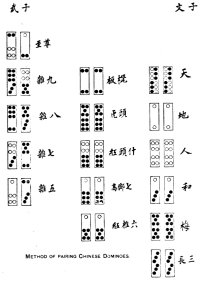
Tá tín kau, "to play heavens and nines," called, like the preceding game from the names of the highest pieces of the two suits, is the best and most highly developed of the Chinese games with dominoes. It is played by 4 persons with 1 set of dominoes.
The 32 pieces are arranged face down in a stack 4 high to form 8 piles of 4 pieces each. One of the players throws 2 dice, and counts around to determine who shall be the first player. He is called tsň chong, "builder of the barn," or chong ká, and usually places some object on the table before him to indicate his position. A disk of wood inscribed with the character chong frequently accompanies sets of dominoes for this purpose.
The first player takes 2 piles of dominoes. If the dice fall near one end of the stack of dominoes, the first player takes the 2 piles at that end, [Page 515] the player on his right the next 2 piles; the third player to the right, the next two, and the fourth player the remaining rows. But if the dice fall near the middle of the stack, the first player takes the 2 middle rows; the player on his right the piles on the right and left of the middle ones, the third player the piles outside of these, and the fourth player the piles at the ends.

The first player leads by placing 1, 2, 3, or 4 pieces face up on the table. One piece of either suit may be led, and a higher piece of the same suit will be required to take it; or a pair of either suit may be led, and a higher pair of the same suit will be required to take it; or one or both pieces of the first, second, third, or fourth pair of one suit (see Plate 5) may be led with one or both pieces of the corresponding pair of the other suit, and 2, 3, or 4 pieces of corresponding higher pairs will be required to take them. That is, one or both of the 6-6 may be led with one or both of the pair 6-3,4-5, and the pair of 1-1 with one or both of the pair 6-9, 5-3, and vice versa.
The other players follow from right to left, by playing as many pieces as are led, putting them on top of those on the table if they are higher, or beneath if they are lower than those already played. They are not required to follow suit. The winner leads again, and the game is continued until all the dominoes have been played.
The player who takes the last round wins the game. He becomes the tsň chong for the next game. It is required of the winner, however, to take at least 2 tricks, that if only 1 piece is led on the last round a player who has not won a trick is not allowed to take the trick, and the game goes to the next higher player.
Tá t'ín kau is invariably played for money. A trick counts 1 point, for which any sum may be agreed upon. At the end of the game the players each pay the winner according to the number of tricks they have taken. The holder of 4 or more tricks pays nothing; of 2 tricks, for 2 points; of 1 trick, for 3 point:, and a player who does not take a trick for 5 points. The first player, or tsň chong, however, always. pays twice the amount when he loses, and is paid double when he wins, and so on throughout the game, paying and receiving in every case twice as much as the other players. Should the tsň chong through winning the last round, hold his position over into the next game, his gains and losses are then in the ratio of 3 to 1 to those of the other players. In the third game they would be as 4 to 1, and so on.
If any player except the first player wins a round with the pair 2-4, 1-2, called chi' tsün, the first player must pay him 4 times, and the other players twice the sum agreed upon for 1 point; but if the first player takes a round with the chi' tsün the other players must pay him 4 times the value of a point.
If any player except the first takes a round with 4 pieces of 2 corresponding pairs, the first player pays him 3 times and the other players 4 times the value of a point, but if the first player takes the round the other players pay him 8 times the value of a point.
[Page 516] If a player takes 2 rounds with the chi' tsün or 2 rounds with 2 corresponding pairs in 2 successive games, the amounts that must be paid him by the other players are doubled, and if he takes 3 such rounds in succession they are trebled. In gambling houses the winner of a round with the chi' tsün must put the value of 1 point and the winner with 2 corresponding pairs of 2 points in a box for the house. This constitutes the only revenue derived by gambling houses from the game.
It is said that the custom of requiring the winner to take at least 2 tricks is an innovation of the last hundred years. Formerly the person taking the last trick became the winner, although it was the only trick taken by him during the game.
Last update January 31, 2010